Boffis
International Hazard
    
Posts: 1836
Registered: 1-5-2011
Member Is Offline
Mood: No Mood
|
|
Potassium Trioxalatochromate III
The preparation of the ferric iron analog of this compound has been widely discussed on this forum but not in detail has the chromium III complex been
discussed before. I required some of this compound for testing organic bases that I am currently working on and decided to prepare some according to
the instructions in the Handbook of Perparative Inorganic Chemistry by Brauer (SM library p1372). However, while I followed to instruction precisely
all did not go well.
I had already done a few test tube scale reactions so that I had at least an idea of what the product should look like. The very dark coloured
crystals are very soluble in water and at high dilution give a beautiful purplish violet colour.
The problem was after adding the prerequisite amount of oxalic acid and potassium oxalate the solution was still brown, very dark brown admittedly but
not the violet colour I was expecting. A quick test with alcoholic diphenylcarbazide revealled the presence of much Cr VI was still present so I added
more oxalic acid straight from the jar. I had to add about another 10g in order to generate a violet product and then about 3ml of 50% KOH solution to
neutralize the solution and raise the potassium content.
I then sat down and began to examine the stoichiometry of the reaction and soon discovered that a great deal more oxalic acid was required that
prescribed in Brauer. In the latter text it specifically states potassium oxalate monohydrate and oxalic acid dihydrate but it is now clear that these
are in fact the weights of anhydrous material required and the reaction is roughly:
K2Cr2O7 + 2K2C2O4H2O +
7C2O4H2(H2O)2 ->
2K3Cr(C2O4)3(H2O)3 + 6CO2 + 17H2O
So my revised receipe is as follows:
Dissolve 15.0 grams of neutral potassium oxalate monohydrate and 36.5g of oxalic acid dihydrate in about 200ml of hot water (a stirrer hotplate
helps). In a separate beaker dissolve 12g of potassium dichromate in 50ml of water with gentle heating. When the chromate salt has dissolved use a
pipette to add this solution to the oxalate+oxalic acid solution by injecting the chromate solution as close to the bottom of the oxalic acid solution
as possible; this helps ensure that all of the chromium VI has been reduced before it reaches the surface and risks being expelled as a fine mist from
the foaming cause by carbon dioxide emmission. The reaction is fairly exothermic and the carbon dioxide generated causes vigorous frothing.
When all of the chromate solution has been added let the solution stand for a few minute until gas evolution ceases and then evaporate down to a small
volume (about 45-50ml) in a shallow bowl on a steam bath or hotplate. Cover and allow to cool slowly and crystallize. A mass of very dark, lustrous
crystals had formed after about 4 hours.
[Edited on 16-5-2019 by Boffis]
|
|
|
woelen
Super Administrator
        
Posts: 7976
Registered: 20-8-2005
Location: Netherlands
Member Is Offline
Mood: interested
|
|
It's not as risky as hexavalent chromium, but keep in mind that oxalic acid and oxalates also are (somewhat) toxic.
I myself made this compound several years ago. I weighed out a mix of finely crushed oxalic acid and finely crushed potassium dichromate in
stoichiometric ratios. This can be done very accurately, because both oxalic acid dihydrate and potassium dichromate are not hygroscopic and the
commercial products are very close (well within 99%) of the theoretical formula. I added 1% additional oxalic acid, just to be sure that there is no
excess hexavalent chromium.
I mixed the chemicals well and then put them in a small beaker, which itself was immersed in cold water, on which a watch glass can be put to avoid
loss of material. Next, I added a small amount of water to set off the reaction. Beware, the reaction is quite violent. Do this outside! A lot of
carbon dioxide is produced and there may be small droplets of solution as well, which make it into the air. That's why I did this experiment outside.
After the reaction you have a very dark purple or green liquid, which solidifies on standing. The precise perceived color depends on the type of light
under which the compound is viewed.
Allow to dry in contact with dry air. The material is nearly pure as is and is absolutely free of hexavalent chromium (I tested that with acidified
H2O2). I did not recrystallize it.
http://woelen.homescience.net/science/chem/compounds/pot_tri...
[Edited on 16-5-19 by woelen]
|
|
|
Boffis
International Hazard
    
Posts: 1836
Registered: 1-5-2011
Member Is Offline
Mood: No Mood
|
|
The main risk with this reaction is the fine mist of droplets produced by the vigorous frothing. As Woelen says its best to do this outside if you
don't have a fume cupboard. In Brauer he states that the oxalate solution is to be added to the dichromate solution but this causes the mist released
to be full of CrVI throughout the addition. I found that the reaction works just as well if the dichromate is added to the oxalate solution and this
way the mist only contains CrIII oxalates and oxalic acid, though still not healthy if inhaled.
There is not enough potassium in the dichromate alone (ratio Cr/K of 1/1) to satisfy the requirement for the final salt which has a Cr/K ration of
1/3, that's why I added the potassium hydroxide solution in my initial preparation. This isn't necessary if the correct amount of potassium oxalte is
used in the first place.
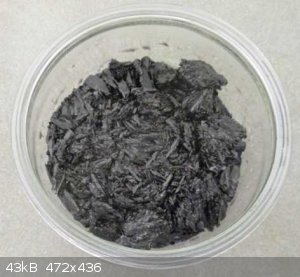
Potassium trioxalatochromate III, the very dark crystals are rather hard to photograph.
|
|
|
crystal grower
Hazard to Others
  
Posts: 474
Registered: 3-1-2016
Location: Os Petrosum
Member Is Offline
Mood: Puzzled
|
|
I tried the procedure written by boffis, but I used round bottom flask instead, to limit some of the mist getting away. I wonder if it's possible to
crystallize it via room temp. evaporation, or is it gonna decompose over tíme?
|
|
|
Boffis
International Hazard
    
Posts: 1836
Registered: 1-5-2011
Member Is Offline
Mood: No Mood
|
|
No its quite stable except perhaps over prolonged exposure to bright light. The Manganese III, iron III and cobalt III analogs are all light sensitive
which is why I decided to use the chromium analog. I simply evaporated mine down on the hotplate, slowly, over about 1.5 hours in a shallow bowl,
poured it into a small beaker and rinsed the bowl with 2ml of water. The photograph above is of these crystals with the liquid simply pour off. The
crystals are glassy, almost black and practically opaque but are completely soluble again in a little water.
I am sure you can evaporate it at room temperature and grow really nice crystals. The solid doesn't seem to be hydroscopic or deliquescent so it
should evapoarte to dryness in the end.
I have just repeated this experiment and found that to reduce all of the CrVI required slightly more than the theoretical amount of oxalic acid, 37.3g
in total of oxalic acid.
[Edited on 16-5-2019 by Boffis]
|
|
|
Texium
|
Thread Pruned
7-11-2019 at 11:16 |
Lion850
National Hazard
   
Posts: 514
Registered: 7-10-2019
Location: Australia
Member Is Offline
Mood: Great
|
|
I had a go at making this. There used to be a site online called Thomas-something that listed many preparations and I think this is where I copied the
procedure from. But that site seemed to have stopped working a while ago. What I copied said:
"To a solution of 23 g. of potassium oxalate monohydrate
and 55 g. of oxalic acid dihydrate in 800 ml. of water is
added 19 g. of powdered potassium dichromate in small
portions with vigorous stirring. When the reaction is
ended, the solution is evaporated nearly to dryness and
allowed to crystallize. Potassium .trioxalatochromiate
forms deep-green crystals with a brilliant blue iridescence"
I did the experiment on half scale:
- 11.5g potassium oxalate monohydrate and 27.5g oxalic acid (I assumed the dihydrate) added to 400ml water in a beaker, heat and stir to dissolve.
- Added 9.5g potassium dichromate in small portions with vigorous stirring.
- There was a very slow reaction - a gentle release of bubbles. I am not sure why in my case the reaction seemed much slower than described earlier in
this thread, can it be because my solution was more dilute?
- The solution went from white to brown to eventually dark over 30 minutes or so, photos below.
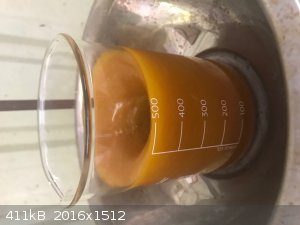 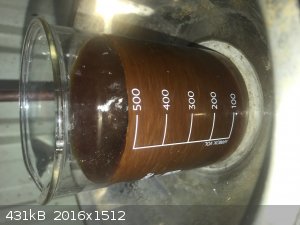 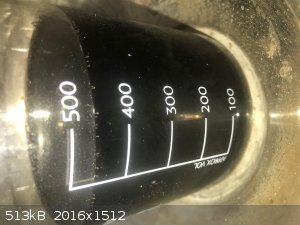
The gentle release of bubbles continued for hours. Eventually after 6 hours there was no more bubbles and that was also the end of the day.
- The next day the solution was steamed down. When it go to around 30-40ml crystals formed. The solution was then cooled and in the process became a
wet solid.
- The black product was scooped out and dried under a steel dish in the sun. After 4 hours it was much drier; I ran out of patience by then and put it
on the steam bath for 2 hours. The steam bath drying did not seem to change the color or appearance and there was no smell; i.e. no obvious
decomposition.
- The crystals looked lovely, black and glittering. They formed some hard layers in the drying dish and had to be scratched out.
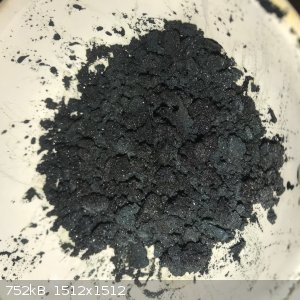
Final recovery was 28.5g which is some 90% of the theoretical. Color is black with maybe a hit of green. It is easily soluble in water and a dilute
solution appears violet when light is shined through it.
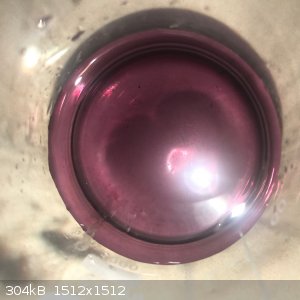
From what I can see online most photos showed a similar black-ish color. Did anyone get this as descrived above "deep-green crystals with a brilliant
blue iridescence"?
|
|
|
vano
National Hazard
   
Posts: 661
Registered: 22-3-2019
Location: Georgia
Member Is Offline
|
|
What do you think succinic acid complex is possible? Is it worth doing?
[Edited on 7-12-2020 by vano.kavt]
|
|
|
Lion850
National Hazard
   
Posts: 514
Registered: 7-10-2019
Location: Australia
Member Is Offline
Mood: Great
|
|
Hi vano.kavt I had to google succinic acid, never heard of it before. Probably worth a try!
I want to try to make copper gluconate; only reason being that I was given a lot of calcium gluconate....
|
|
|
vano
National Hazard
   
Posts: 661
Registered: 22-3-2019
Location: Georgia
Member Is Offline
|
|
Quote: Originally posted by Lion850  | Hi vano.kavt I had to google succinic acid, never heard of it before. Probably worth a try!
I want to try to make copper gluconate; only reason being that I was given a lot of calcium gluconate.... |
I bought succinic acid on Amazon and it is very high quality. Definitely trying to look interesting. It is smaller than in the photo. Copper gluconate
is very nice compound.
https://www.amazon.com/gp/product/B009JH2CME/ref=ppx_yo_dt_b...
[Edited on 7-12-2020 by vano.kavt]
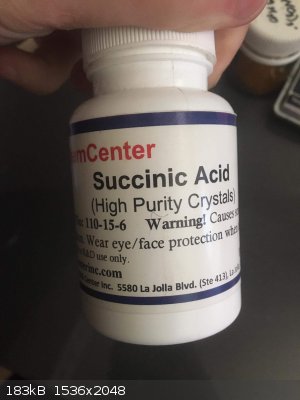
[Edited on 7-12-2020 by vano.kavt]
|
|
|
vano
National Hazard
   
Posts: 661
Registered: 22-3-2019
Location: Georgia
Member Is Offline
|
|
I did it. Potassium Trisuccinatochromate III. Its very nice and unusual yellowish-green compound. Its solluble in water.
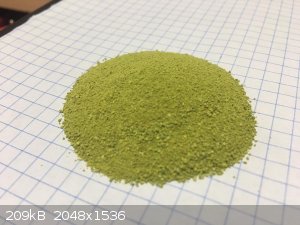
|
|
|
teodor
National Hazard
   
Posts: 872
Registered: 28-6-2019
Location: Heerenveen
Member Is Offline
|
|
Did you make it by reducing Cr(VI)? If so, what is the reducing agent?
[Edited on 7-12-2020 by teodor]
|
|
|
vano
National Hazard
   
Posts: 661
Registered: 22-3-2019
Location: Georgia
Member Is Offline
|
|
Quote: Originally posted by teodor  | Did you make it by reducing Cr(VI)? If so, what is the reducing agent?
[Edited on 7-12-2020 by teodor] |
I did the same as the others. I used succinic acid instead of oxalic acid.
|
|
|
teodor
National Hazard
   
Posts: 872
Registered: 28-6-2019
Location: Heerenveen
Member Is Offline
|
|
Are the oxidation products of succinic acid by dichromate the same as oxalic acid, CO2 and water?
|
|
|
vano
National Hazard
   
Posts: 661
Registered: 22-3-2019
Location: Georgia
Member Is Offline
|
|
I think it produced carbon dioxide. I heated solution and It was brown slightly black. I filtered it and evaporated any water. Maybe it is
nonanhydrate.
[Edited on 7-12-2020 by vano.kavt]
|
|
|
vano
National Hazard
   
Posts: 661
Registered: 22-3-2019
Location: Georgia
Member Is Offline
|
|
The malonic acid complex is also interesting. I have malonic acid in another house and I can not make it this time. I am very interested in how
different colors they will have from each other.
|
|
|
Bedlasky
International Hazard
    
Posts: 1219
Registered: 15-4-2019
Location: Period 5, group 6
Member Is Offline
Mood: Volatile
|
|
Vano.kavt: Very nice result. I really like your unusual ideas.
But I think that using succinic acid as reducing agent is waste of precious reagent. I think that mixing of solutions of metabisulfite(or
ethanol)+succinic acid and acidified potassium dichromate is better. Metabisulfate or ethanol are cheap reducing reagents. So you need succinic acid
just as complexing reagent. Be careful, reaction between dichromate and ethanol is quite exothermic.
|
|
|
vano
National Hazard
   
Posts: 661
Registered: 22-3-2019
Location: Georgia
Member Is Offline
|
|
Quote: Originally posted by Bedlasky  | Vano.kavt: Very nice result. I really like your unusual ideas.
But I think that using succinic acid as reducing agent is waste of precious reagent. I think that mixing of solutions of metabisulfite(or
ethanol)+succinic acid and acidified potassium dichromate is better. Metabisulfate or ethanol are cheap reducing reagents. So you need succinic acid
just as complexing reagent. Be careful, reaction between dichromate and ethanol is quite exothermic. |
Thank you so much Bedlasky. I was given Amazon gift cards so this and many other reagents are free for me. I can also buy succinic acid very cheaply
in my city. That's why I'm not worried about this loss. Yes i know its quite exothermic. As for the reaction between chromium trioxide and ethanol is
awful.
|
|
|
woelen
Super Administrator
        
Posts: 7976
Registered: 20-8-2005
Location: Netherlands
Member Is Offline
Mood: interested
|
|
Very interesting! I have sodium hydrogen succinate and had no real application for it. Now I know what to do with this compound! The color of this
complex indeed is quite special for chromium(III). I also made the trisoxalato complex and its color strongly depends on the light under which it is
observed. Under fluorescent light it looks grey, like your pictures, but under tungsten light it looks green.
|
|
|
vano
National Hazard
   
Posts: 661
Registered: 22-3-2019
Location: Georgia
Member Is Offline
|
|
It would be nice if you could do the same and compare the photos. I am going to use tartaric acid next.
|
|
|
teodor
National Hazard
   
Posts: 872
Registered: 28-6-2019
Location: Heerenveen
Member Is Offline
|
|
Are there limitations which carboxylic acids could be used as a complexing agent? 2 examples before were about dicarboxylic acids and now you are
talking about tartaric acid. Could straight-chain carboxylic acids be used for the same purpose then?
|
|
|
vano
National Hazard
   
Posts: 661
Registered: 22-3-2019
Location: Georgia
Member Is Offline
|
|
Quote: Originally posted by teodor  | | Are there limitations which carboxylic acids could be used as a complexing agent? 2 examples before were about dicarboxylic acids and now you are
talking about tartaric acid. Could straight-chain carboxylic acids be used for the same purpose then? |
I do not know I havent any information, but I will know when I try.
|
|
|
EthidiumBromide
Harmless

Posts: 42
Registered: 27-9-2020
Member Is Offline
Mood: Effervescent
|
|
I'd assume denticity comes into play here. Straight-chained, monocarboxylic acids will be poorer ligands than dicarboxylic acids, because you have
less atoms on the molecule that can form a coordinate bond with the metal centre. Judging by the presence of additional hydroxyl groups, tartaric acid
may be a better ligand than succinic acid.
I know this is the case with alcohols. You won't get a complex to form between Cu2+ and ethanol nor methanol. But ethylene glycol and glycerol on the
other hand will form a coordination complex with Cu2+, thanks to additional hydroxyl groups on the molecule, which increase the denticity of these
ligands.
[Edited on 7-12-2020 by EthidiumBromide]
|
|
|
teodor
National Hazard
   
Posts: 872
Registered: 28-6-2019
Location: Heerenveen
Member Is Offline
|
|
It would be interesting to combine this property with some organic synthesis where the desired product is isolated from the reaction by complexing
with Cr(III) or other transitional metal.
|
|
|
Bedlasky
International Hazard
    
Posts: 1219
Registered: 15-4-2019
Location: Period 5, group 6
Member Is Offline
Mood: Volatile
|
|
I did some experiments with Cu(II) complexes with polyhydroxy compounds. Polyhydroxy compounds also form complexes with boric acid, which increase its
ionization - this is used in analytical chemistry in volumetric determination of boric acid, D-mannitol is often used as complexing agent for boric
acid, but fructose or glycerol are also very good.
|
|
|
DraconicAcid
International Hazard
    
Posts: 4278
Registered: 1-2-2013
Location: The tiniest college campus ever....
Member Is Offline
Mood: Semi-victorious.
|
|
I would expect malonic, maleic ans succinic acids to make similar complexes to the oxalates (I've had middling success with Cu(II) and these ligands,
along with the Fe(III) malonate complex). With lactate, you should also get a chelate (it complexes copper nicely, but I was unable to isolate the
complex), but it will probably give you stereoisomers (mer and fac), which may complicate the isolation.
Please remember: "Filtrate" is not a verb.
Write up your lab reports the way your instructor wants them, not the way your ex-instructor wants them.
|
|
|